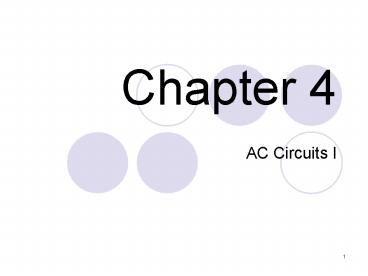AC Circuits I - PowerPoint PPT Presentation
1 / 28
Title:
AC Circuits I
Description:
Write the equation for both an ac sinusoidal voltage and sinusoidal current. ... Inductances are replaced by purely imaginary impedances of the form j?L. ... – PowerPoint PPT presentation
Number of Views:30
Avg rating:3.0/5.0
Title: AC Circuits I
1
Chapter 4
- AC Circuits I
2
Objectives
- Write the equation for both an ac sinusoidal
voltage and sinusoidal current. - For a sinusoidal function, determine the peak
value, angular frequency, cyclic frequency,
period, and phase angle. - State Eulers equation and discuss its
significance in establishing ac phasors
3
Objectives
- Discuss the properties of the complex plane and
show how a phasor is displayed. - State the rectangular, exponential, and polar
forms of a phasor and convert among the different
forms. - State the ac steady-state voltage-current
relationships for the three passive parameters.
4
Objectives
- Determine the steady-state ac impedances for the
three passive parameters. - Convert a circuit to its ac phasor form with
sources replaced by phasors and passive
parameters replaced by their real, imaginary, or
complex impedances.
5
Objectives
- Solve for phasor voltages and currents in a
steady-state ac circuit and determine the
instantaneous forms from the phasors. - Show how phasors add graphically in a complex
plane.
6
4-1 Sinusoidal Functions
7
Sine Current Function
8
Cosine Current Function
9
General Sinusoidal Current with an Arbitrary
Phase Angle
10
Relative Phase Sequence of Sine and Cosine
Functions
11
4-2 Phasors
12
Complex Plane with Phasor Representation
13
Generation of Sinusoidal Function by a Rotating
Phasor
14
Examples
- v1(t) 8 sin(1000t 60)
- v2(t) 6 cos(1000t -120)
- i(t) 2 sin(1000t 150)
15
Phasor Diagram of Example 4-5
16
4-3 AC Voltage-Current Relationships
17
Phasor Diagram for Resistance and the
Instantaneous Sinusoidal Forms
18
Phasor Diagram for Inductance and the
Instantaneous Sinusoidal Forms
19
Phasor Diagram for Capacitance and the
Instantaneous Sinusoidal Forms
20
4-4 AC Impedance
- Convert the sinusoidal sources (all at the same
frequency) to phasors having magnitudes and
angles. - Convert all elements in the circuit to their
steady-state impedance forms as follows - Resistance values remain the same.
- Inductances are replaced by purely imaginary
impedances of the form j?L. - Capacitances are replaced by purely imaginary
impedances of the form j/?C. - Various circuit analysis methods may now be
applied to the circuit to determine voltages or
currents in phasor forms. - If it is necessary to determine the instantaneous
forms, phasors may be converted to those forms.
21
Block Used to Define Impedance
22
Resistance and its AC Impedance Form
23
Inductance and its AC Impedance Form
24
Capacitance and its AC Impedance Form
25
RL Circuit of Example 4-6 and its Phasor Form
26
RC Circuit of Example 4-7 and its Phasor Form
27
RLC Circuit of Example 4-8 and its Phasor Form
28
Phasor Diagram for Example 4-8

